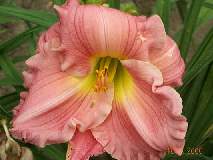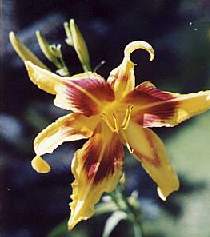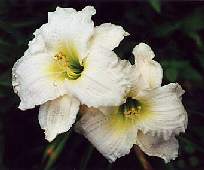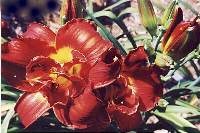Willow Brook Acres does not recommend the ads on
this page
Actually our quality and prices are hard to beat.
|
Search Our Site <Contact
Us>
Our
Daylily List How
To Order Linda's
Great Gardener's Soap Available with your daylily order, no extra shipping
for up to 4 bars. $4.00 each Inventory
List Willow Brook Acres Gentle Shepherd CLICK
HERE Our Growing Fields Night
Wings
Make Plant Tags
See The Daylily
How
To Plant
Find
Your Plant
Hardiness


RED RAIN |
What is A Daylily? What's the difference... between
a daylily and a lily? When you hear the word "daylily" do you think about the tall, white, sweet smelling flower commonly seen growing in pots at Easter time? If you do you aren't alone. A daylily, however, is not a lily. The lily is from the genus Lilium and family Liliaceae. It grows from a bulb similar to a tulip bulb, both looking a lot like the common onion. They are planted about 6" deep during spring or fall. The flower buds form on top of a tall stalk of feather like leaves. The one similarity between the lily and the daylily is its trumpet shaped flowers. The da Hemerocallis means, "beauty for a day." Individual flowers only last one day, thus the name "daylily." While the life of a single blossom is short lived, the number of scapes and buds give the illusion of a long blooming flower. Daylilies for the ordinary gardener. Willow Brook Acres is proud to be the kind of daylily grower that loves to sell to the ordinary gardener. We have a large selection of moderately priced, true division daylilies. Some are lower priced than the same daylily bought in a local garden center. We believe a daylily priced as a bare root, field grown division is a better value over the small, tissue cultured, greenhouse fans potted up at a local garden center at 2 or 3 times the price. We also grow newer cultivars for the gardener that wants something new and different in their garden. Garden centers don't usually grow the latest daylily cultivars. How to buy... Choosing your first daylily is easy. You buy what you like. Daylilies are available through specialized growers, such as Willow Brook Acres. Or they are found growing in pots beside other perennials at local nurseries and plant sellers. The identification tag that comes with the potted daylily will tell you the color, height, and bloom season. Sometimes there is a picture of the bloom. You will also find a registered name. When daylilies are registered they are given a unique, friendly name which distinguishes one cultivar from another with its particular set of characteristics. It is a friendly name because it is plain English. For example, "Whimsical," "Anna" or "Stroke of Midnight," to name a few.  ...and grow the daylily The daylily is called "the perfect perennial" because it is beautiful but easy to grow. They aren't fussy plants and they don't require hard to remember growing conditions. Just remember a few simple rules of good gardening. (1) Good soil gives the best results. (2) More sunlight produces the most bloom, and (3) all plants need adequate water. While daylilies are drought tolerant, they prefer moist well drained soil. Normally they do not require extra watering, but newly divided or transplanted daylilies should be watered to keep them moist if the weather is dry. Good garden loam is soil that is not hard or heavy clay. If you can turn the soil to loosen it, then plunge your fingers deep into the earth to grab a handful of the dirt, you probably have adequate soil to start with. Try a simple test. Squeeze the handful of slightly moist dirt into a compressed ball. If it easily crumbles again with a little pressure, your soil is good.
Top dress your established daylily beds with fresh compost and a little of the decomposed cow manure. Loosen the soil around the individual plants, working the top dressing a few inches in to the soil. Daylilies require very little care on a day to day basis in the garden. To keep your garden tidy you will want to clip any dead leaves and remove the spent flower scapes. Any seed pods that form should be removed unless you intend to grow daylilies from seed. Also daylilies may need to be divided every 3-4 years. A daylily will flourish on the shady side of your house as well as in the sunniest location. But remember the rule, more sun produces more bloom in some cases. Some daylily colors are better with a a little after noon shade. In the hottest southern states some growers construct shade houses, a mesh cloth tarp type structure to keep the daylilies from being stressed from the intense sun. Shade is important for hybridizers to set seeds on some pod parent plants.Tip: For some reason a daylily that doesn't seem to be vigorous in one garden spot may benefit from being moved to another location. Caring for the Daylily
What's A Double Fan? When "Consider the lilies how they grow: they toil not, they spin not; and yet I say unto you, that Solomon in all his glory was not arrayed like one of these." KJV St. Luke 12:27
©
Copyright
Policy | |||||







 ylily is a true perennial
from the genus Hemerocallis and family Hemerocallidaceae. It
does not grow from a bulb. The
roots grow in a
ylily is a true perennial
from the genus Hemerocallis and family Hemerocallidaceae. It
does not grow from a bulb. The
roots grow in a  you buy a freshly dug, bare root daylily, the division
that has a root, crown and foliage, is called a
"fan." A single fan resembles a leek or green
onion. A "double fan" is a generous root division
that has two green "fans." If, however,
you order from a commercial catalog supplier instead of a daylily grower, the price is
usually for a small single daylily root.
you buy a freshly dug, bare root daylily, the division
that has a root, crown and foliage, is called a
"fan." A single fan resembles a leek or green
onion. A "double fan" is a generous root division
that has two green "fans." If, however,
you order from a commercial catalog supplier instead of a daylily grower, the price is
usually for a small single daylily root.